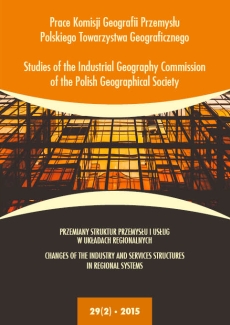Differentiation and dynamics of regional development in Central and Eastern European Countries in the period of prosperity and austerity
DOI:
https://doi.org/10.24917/20801653.292.3Keywords:
illamson hypothesis, convergence, CEE countries, economic crisis, regional developmentAbstract
The aim of the paper is to demonstrate the scale of regional disparities and the dynamics of regional development in Central and Eastern European Countries (CEECs). The article attempts to answer the following research questions: a) does regional development of the CEE countries corroborate the J. G. Williamson (1965) hypothesis concerning the relationship between the level of national income and the extent of regional disparities, b) what are the main reasons for changing the scale of regional differences, and c) how economic crisis has affected the dynamics of regional development. Empirical studies have shown a decrease in the rate of regional divergence with increasing income levels in different countries. This occurred under the conditions of regional economic structure petrification - especially after excluding capital city regions from the analysis - which may indicate a balance between spread and backwash effects in the period of economic prosperity - especially in the years 2004-2008. The outcome of the first phase of the economic crisis was quite patchy regarding regional development pattern, but with noticeable better adaptability of majority of capital city regions.
Downloads
Metrics
References
Boldrin, M., Canova, F. (2001). Inequality and convergence in Europe’s regions: reconsidering European regional policies. Economic Policy, 16(32), 205–253.Capello, R. (2007). Regional economics. Londyn i Nowy Jork: Routledge.
ESPON Project 1.1.1. (2004). Potentials for polycentric development. Potentials for polycentric development in Europe. Sztokholm: NORDREGIO. Pozyskano z http://www.espon.eu/.
Eurostat (2015). Pozyskano z http://ec.europa.eu/eurostat.
Ezcurra, R., Pascual, P., Rapu, M. (2007). The Dynamics of Regional Disparities in Central and Eastern Europe during Transition. European Planning Studies, 15(10), 1397–1421.
Gorzelak, G. (1996). The regional dimension of transformation in Central and Eastern Europe. Londyn: Jessica Kingsley Publishers.
Gorzelak, G. (2011). The financial crisis in Central and Eastern Europe. W: G. Gorzelak (red.). Financial Crisis in Central and Eastern Europe: From Similarity to Diversity. aWarszaw: Wydawnictwo Naukowe Scholar.
Gorzelak, G., Smętkowski, M. (2010). Regional Development Dynamics in Central and Eastern European Countries. W: G. Gorzelak J. Bachtler, M. Smętkowski (red). Regional Development in Central and Eastern Europe Development processes and policy challenges. Oxon-Nowy Jork: Routledge.
OECD (2010). Regional Development Policies in OECD Countries. Francja: OECD Publishing.
Orłowski, W.M. (2010). W pogoni za straconym czasem. Wzrost gospodarczy w Europie Środkowo--Wschodniej. Warszawa: PWE.
Petrakos, G. (2001). Patterns of regional inequality in transition economies. European Planning Studies, 9, 359–383.
Römich, R. (2003). Regional disparities within accession counties. W: G. Tumpel-Gugerell,P. Mooslechner. Economic convergence and divergence in Europe: growth and regional development in an enlarged European Union. Cheltenham: Edward Elgar.
Smętkowski, M. (2013). Rozwój regionów i polityka regionalna w krajach Europy Środkowo--Wschodniej w okresie transformacji i globalizacji. Warszawa: Wydawnictwo Naukowe Scholar.
Smętkowski, M., Gorzelak, G., Kozak, M., Olechnicka, A., Płoszaj, A., Wojnar, K., (2011) EuropeanMetropolises and Their Regions: From Economic Landscape to Metropolitan Networks. Warszawa: Wydawnictwo Naukowe Scholar.
Smętkowski, M., Wójcik P. (2012). Regional Convergence in Central and Eastern European Countries– a multidimensional approach. European Planning Studies, 20(6), 923–939.
Vernon, R. (1966). International Investment and International Trade in the product cycle. Quarterly Journal Economics, 80(2), 190–207.
Williamson, J.G. (1965). Regional inequalities and the process of national development. Economic Development and Cultural Change, 13.
World Bank (2009). World Development Report 2009. Reshaping Economic Geography. Pozyskano z https://openknowledge.worldbank.org/handle/10986/5991.
Downloads
Published
How to Cite
Issue
Section
License
Articles are published under the terms of the Creative Commons License (CC BY-ND 4.0; Attribution– NoDerivs).

